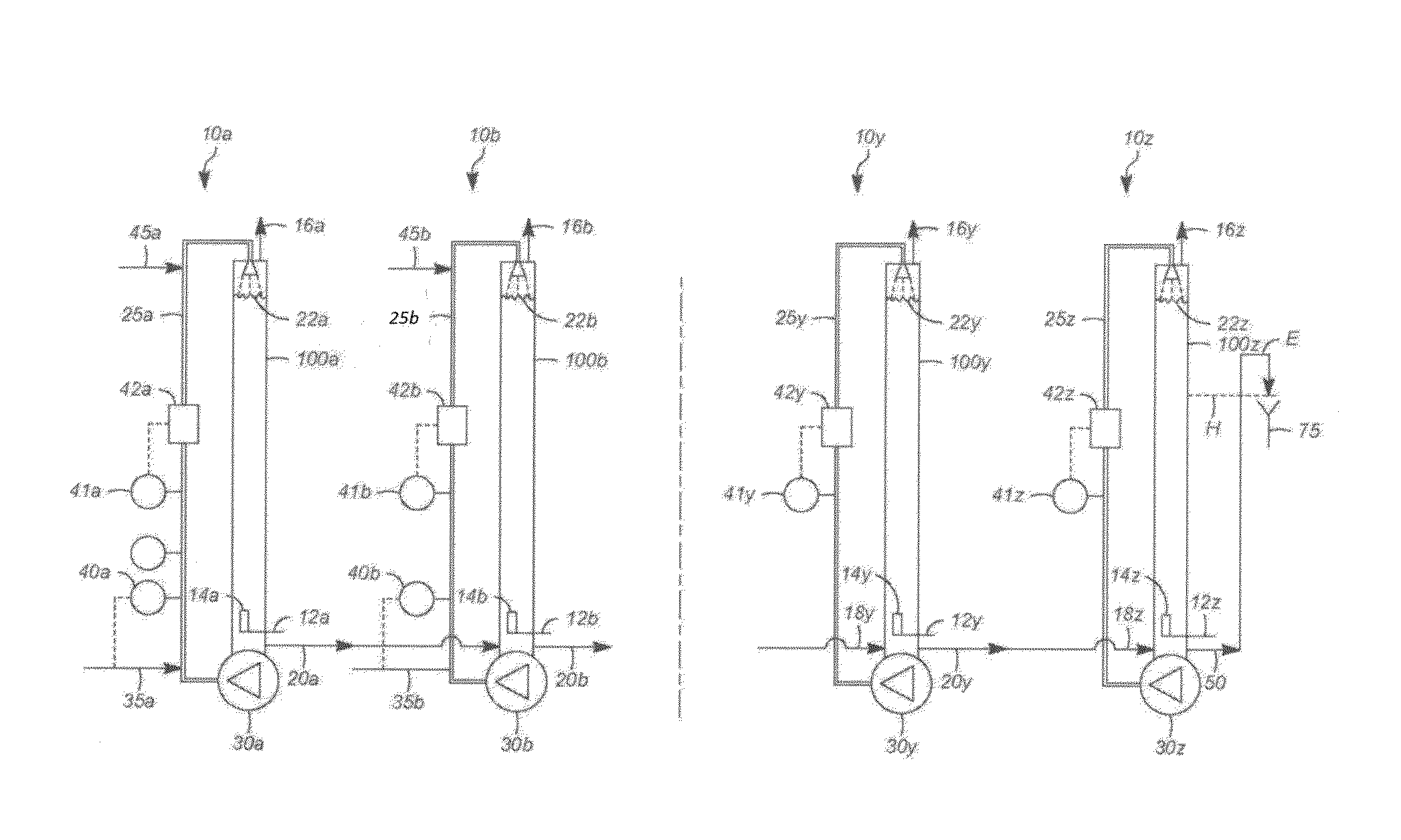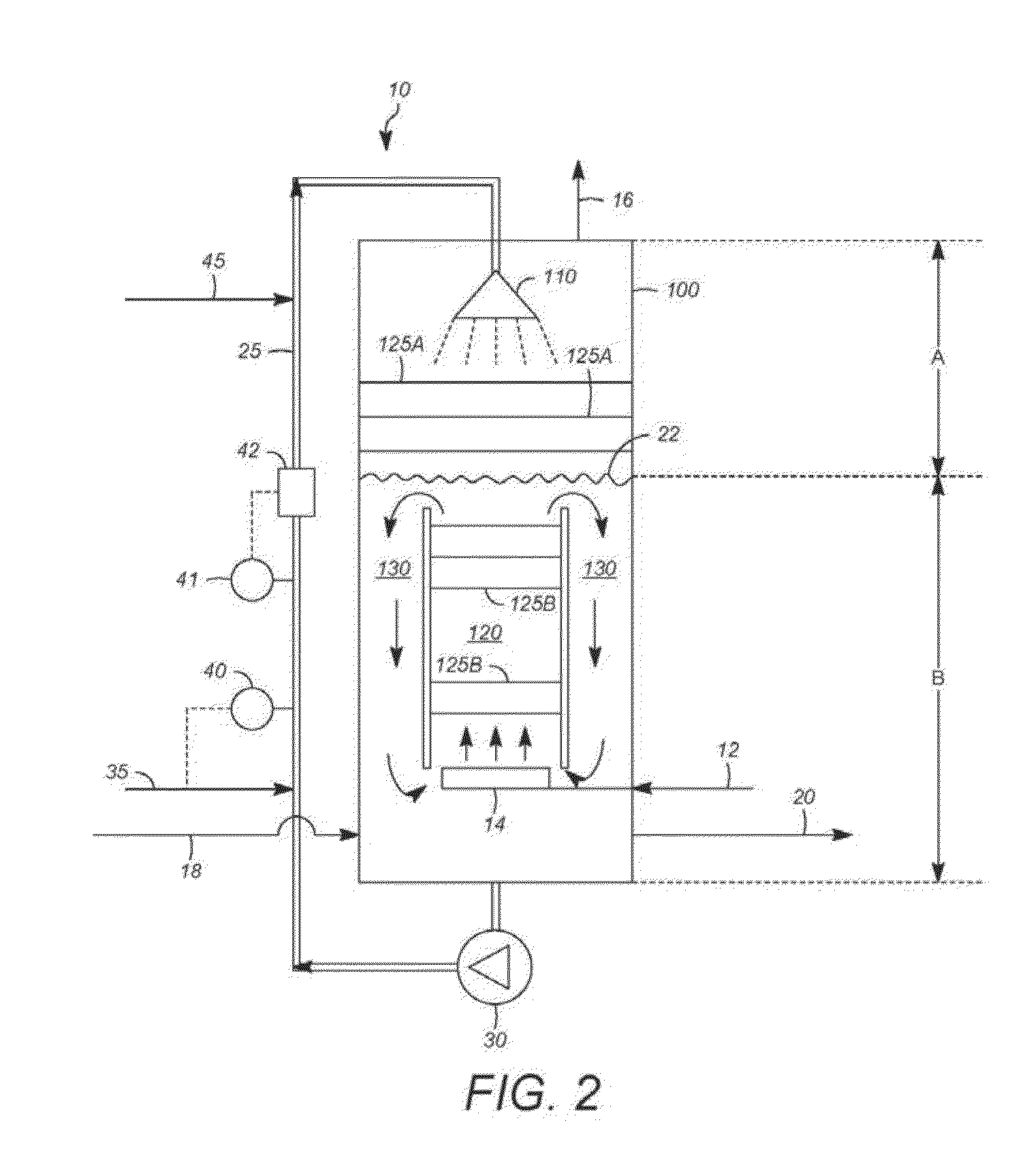Multi-stage bioreactor processes
a bioreactor and process technology, applied in bioreactors/fermenters, biomass after-treatment, biofuels, etc., can solve the problems of low productivity of undesired metabolites such as acetic acid so as to achieve efficient overall c1 carbon source utilization, high overall ethanol productivity, and low productivity
- Summary
- Abstract
- Description
- Claims
- Application Information
AI Technical Summary
Benefits of technology
Problems solved by technology
Method used
Image
Examples
example 1
Experimental Setup
[0093]A test rig having six stages comprising bioreactors, each with a 1.5 liter working volume (for a total reactor volume of 9 liters for the system) was used for the extended evaluation of a multi-stage biological conversion process as described herein. Specifically, these processes used counter-current, liquid downflow loop reactors having main columns of about 1.2 meters high and 50 millimeters in diameter and constructed of clear PVC plastic for observation of hydrodynamics. The fifth and sixth stages had somewhat taller main columns. A plastic, low pressure centrifugal pump (aquarium duty, 500-2000 L / / h) at the bottom of each column was used to recycle liquid to a full-cone shower head liquid distributor at the top of the column. The pressure drop across each shower head was low, on the order of 20-40 kPa.
[0094]Gas entered each bioreactor stage separately and near the bottoms of the columns, through sintered stainless steel spargers. Un-utilized and undissol...
example 2
Initial, Shakedown Operation
[0095]An initial operation was designed to test the effectiveness of a multi-stage bioreactor system for the biological conversion of CO in a gaseous CO-containing substrate to ethanol and other metabolites, in the presence of a bacterial culture medium containing C. autoethanogenum. A simplified version of the test rig as described in Example 1 was employed, without headspace shower sprays, i.e., the continuous vapor phase zone was an open pipe. Nor were any spargers used, i.e., gas was introduced into the continuous liquid phase zone through an open, 3 mm inner diameter tube. Temperature control on the bioreactors of the fifth and sixth stages was lacking, and liquid level control was maintained with a simple, overflow liquid system (shared gas outlet). The bioconversion operation achieved stable bacterial growth for 2 weeks, eventually reaching an operating point of >43 grams / liter of ethanol production with <2 grams / liter of acetate production, based ...
example 3
Modified Operation, Based on Hydrodynamic Observations
[0096]In a second operation, modifications were made to arrive at the test rig substantially as described in Example 1. These modifications, based on hydrodynamic evaluation of the testing in Example 2, included establishing “liquid only” connections between the stages, using 1.5 mm inner diameter, stainless steel tubing attached at the bottoms of the columns. This diameter was determined to be sufficiently small to prevent back mixing at the operating rates of culture medium addition (dilution rates). In view of these liquid connections at the bottoms of the reactors, an adjustable height outlet for the final stage liquid product, exiting the sixth bioreactor, was added for liquid level control throughout the system. Also, full cone headspace shower sprays were added to all of the bioreactors for liquid distribution, and temperature control systems were added on the external liquid recycle loops of the final two reactor stages. ...
PUM
 Login to View More
Login to View More Abstract
Description
Claims
Application Information
 Login to View More
Login to View More - R&D
- Intellectual Property
- Life Sciences
- Materials
- Tech Scout
- Unparalleled Data Quality
- Higher Quality Content
- 60% Fewer Hallucinations
Browse by: Latest US Patents, China's latest patents, Technical Efficacy Thesaurus, Application Domain, Technology Topic, Popular Technical Reports.
© 2025 PatSnap. All rights reserved.Legal|Privacy policy|Modern Slavery Act Transparency Statement|Sitemap|About US| Contact US: help@patsnap.com



